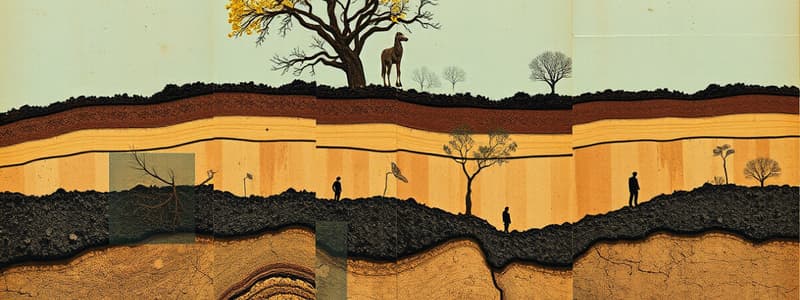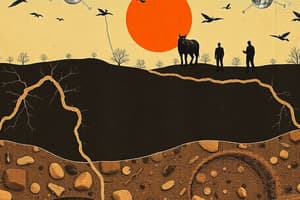Podcast
Questions and Answers
What is soil?
What is soil?
The loose covering of broken rock particles and decaying organic matter (humus).
What is soil formation?
What is soil formation?
The soil-forming process begins when weathering breaks solid bedrock into smaller and smaller pieces.
What is parent material?
What is parent material?
Material from which a soil is formed.
What are horizons in soil?
What are horizons in soil?
What is the O Horizon?
What is the O Horizon?
What is the A Horizon?
What is the A Horizon?
What is the B Horizon?
What is the B Horizon?
What is the C Horizon?
What is the C Horizon?
What is leaching?
What is leaching?
What is soil texture?
What is soil texture?
What is soil porosity?
What is soil porosity?
What is permeability in soil?
What is permeability in soil?
How does climate affect soil?
How does climate affect soil?
What is the effect of topography on soil?
What is the effect of topography on soil?
What is the biological effect on soil health?
What is the biological effect on soil health?
What is sand in soil?
What is sand in soil?
What is silt in soil?
What is silt in soil?
What is clay in soil?
What is clay in soil?
What is humus?
What is humus?
How does humus help soil?
How does humus help soil?
What is bedrock?
What is bedrock?
What is soil composed of?
What is soil composed of?
What does fertility in soil refer to?
What does fertility in soil refer to?
What are soil decomposers?
What are soil decomposers?
What is clay soil composition?
What is clay soil composition?
What is loam soil composition?
What is loam soil composition?
What is sandy soil composition?
What is sandy soil composition?
Flashcards are hidden until you start studying
Study Notes
Soil and Its Formation
- Soil is the loose layer of broken rock particles and decaying organic matter known as humus.
- Soil formation starts with weathering that breaks down solid bedrock into smaller pieces, allowing bacteria, fungi, and insects to thrive.
- The presence of organisms enhances nutrient content through decay, aiding soil development.
Soil Components and Layers
- Parent material forms the basis of soil composition and influences its properties.
- Horizons are distinct layers within a soil profile, each with unique characteristics.
- O Horizon is rich in organic material, containing decaying plant matter.
- A Horizon consists of organic matter and minerals; it's the darkest layer and where most plant roots reside.
- B Horizon accumulates soluble minerals leached from the top layers.
- C Horizon comprises less-weathered sediments and partially weathered parent material.
Soil Processes
- Leaching is the process where chemicals in upper soil layers dissolve and are carried to lower layers.
- Soil texture refers to the percentage distribution of sand, silt, and clay in a soil sample.
- Porosity indicates the amount and size of spaces between soil particles, affecting water retention capacity.
- Permeability is the rate at which water and air move through soil or bedrock.
Environmental Influences on Soils
- Climate affects soil acidity, alkalinity, and the speed of soil-forming processes.
- Topography influences drainage, with steep slopes prone to erosion and instability.
- Biological factors, such as the presence of decomposers, determine soil fertility and nutrient cycling.
Soil Particle Types
- Sand, the largest particle size (0.05 mm - 2 mm), allows for quicker water movement and softer soil texture.
- Silt, with a particle size of 0.002 mm - 0.05 mm, retains more water than sand and feels smooth when wet.
- Clay, the smallest particle size (less than 0.002 mm), makes soil difficult to penetrate and resistant to water infiltration.
Importance of Humus
- Humus enhances soil structure by creating spaces for air and water and contains vital nutrients for plant growth.
Bedrock Significance
- Bedrock is the solid layer of rock beneath soil, integral in soil composition.
Soil Composition Overview
- Soil is a mix consisting of rock particles (weathered bedrock), minerals, decayed organic material (humus), water, and air.
Soil Fertility
- Fertility measures soil's ability to support plant growth; high humus content results in high fertility.
Role of Soil Decomposers
- Decomposers like fungi, bacteria, worms, and mites play crucial roles in breaking down organic matter and enriching the soil.
Soil Types
- Clay soil: 15% silt, 15% sand, 70% clay; high in nutrients but challenging to work with and prone to waterlogging.
- Loam soil: 40% silt, 40% sand, 20% clay; most suitable for agriculture as it retains moisture while preventing waterlogging.
- Sandy soil: 20% silt, 65% sand, 15% clay; easy to cultivate but susceptible to drought due to lack of moisture retention.
Studying That Suits You
Use AI to generate personalized quizzes and flashcards to suit your learning preferences.




